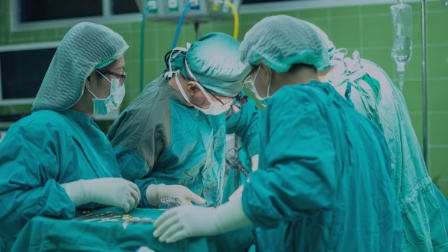Oh, there’s an issue with your appendix. We’ll need to get another surgeon across to remove your appendix. There seems to be a tumour-like growth on your appendix and there is mucous leaking around your abdomen.”


Oh, there’s an issue with your appendix. We’ll need to get another surgeon across to remove your appendix. There seems to be a tumour-like growth on your appendix and there is mucous leaking around your abdomen.”

Cytoreductive surgery (CRS) for pseudomyxoma peritonei (PMP) is a complex operation with the aim of removing all visible tumours, affected tissue and entire organs. The NICE guidelines recommends the Sugarbaker technique and defines the operation as radical.

My journey started in October 2013 (I was 53 years old), when I had an ultrasound to determine if I had gallstones or an issue with my gallbladder. The results showed a small cyst and mild fluid in my lower right abdomen area. It was decided that we would monitor the cyst and fluid and have an MRI in one year. We thought it was nothing more than an ovarian cyst. I never thought it would lead to a diagnosis of Mucinous Appendiceal Adenocarcinoma.
I didn’t have any related symptoms before my diagnosis. I went to the urologist for some UTI treatment. The doctor (my hero) ordered a CT scan. That was the beginning of my journey. PMP is so rare and the right treatment is so important. You have to do research just to find the right medical team that is experienced in treating PMP. My wife and family, of course, were there for me.
After being rushed to the hospital with suspected appendicitis, Sandra underwent surgery. However, upon waking up from the procedure, she received the diagnosis of pseudomyxoma peritonei (PMP).
He asked if I drank a lot, thinking it was a liver problem causing accumulation of fluid in the abdomen. He requested an ultrasound, which revealed the presence of intense ascites. There seemed no other abnormalities.
Following an abnormal smear, I was referred to my local gynaecological oncology centre where an ultrasound scan revealed a complex mass believed to be ovarian in nature.
I was working as a daybaker and would come home and fall asleep on the sofa soon after I got home. I was exhausted and, despite exercising regularly and when my mother asked me if I was pregnant I began to feel unsettled. I also experienced some back pain that felt like my muscles were torn apart (like Velcro).
I went to the doctor as I could feel a swelling and, yes, the doctor could feel it too. After taking pregnancy test under the doctor’s instruction, I was sent for an ultrasound.
In the summer of 2008, after having pains in my side, which turned out to be gallstones, and not feeling at all well I went to see my doctor who sent me to Bristol General Hospital to have an ultrasound scan. During the examination, the radiologist was rather puzzled by, as she said ‘a fluid in my stomach’.